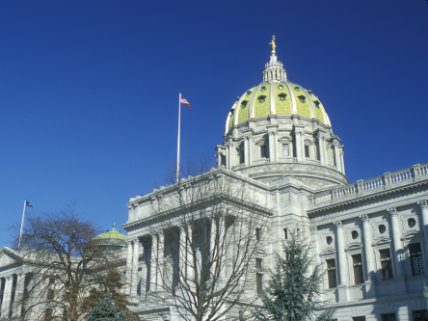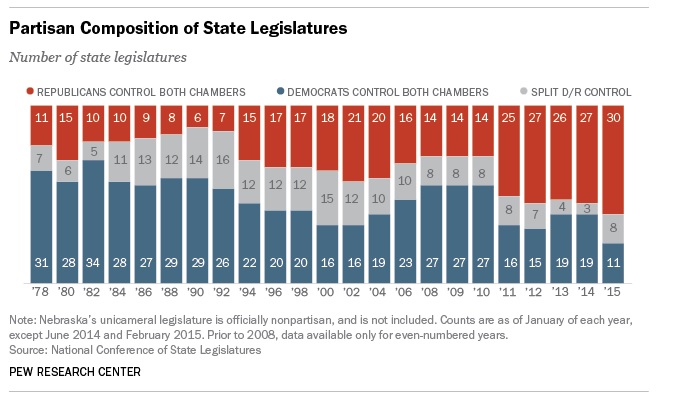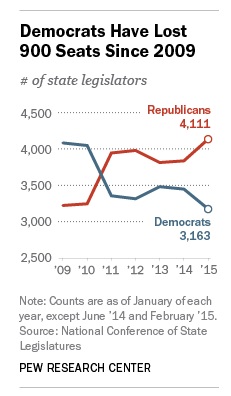If You Want To Understand Politics in 2024, Watch Statehouse Races Tuesday
They're not sexy, but they're more important than you realize. Republicans can thank state-level races for their congressional majority.

State legislative elections don't get much attention, even in years when the presidential race isn't the only thing anyone talks about for months on end. But those local races do more than simply determine which lawmakers get a desk in the state capitol.
In more ways than one, state legislative races shape the foundation of government—and not only in faraway places like Harrisburg, Springfield, and Raleigh. If Hillary Clinton wins the White House but Republicans hold their majority in the U.S. House (as is likely), it will be in large part because of the victories Republicans have won in state-level races over the past decade. In most states, controlling state legislatures means controlling the ability to redraw congressional districts and giving your own party an electoral advantage before any voters line-up at the polls. The massive advantage that the GOP holds at the state level is something Democrats will have to reverse if they want a realistic shot at winning full control of Congress any time before 2030.
They've got a lot of work to do.
Heading into Election Day 2016, Republicans control both chambers in 30 state legislatures, while Democrats have dual-house control in just 12 states. There are seven states with Republican majorities in one chamber and Democratic majorities in another. Unofficially, Republicans also control Nebraska's unique unicameral legislature (all Nebraskan lawmakers are technically "nonpartisan" but party affiliations are hardly a secret and 35 of the chamber's 49 members are affiliated with the Republican Party).
Contrast that with where things stood when Obama was elected for the first time in 2008. Following that election, Democrats had control of both chambers in 27 states, while Republicans held all the cards in only 14 states.
Then 2010 happened.
The midterm election swept Republicans into control of both chambers of Congress, but it also produced an astounding swing in control of state legislatures.

Even as Democrats re-elected Barack Obama comfortably in 2012 and made small inroads against the GOP congressional majority, the GOP tightened their grip on state legislatures.
Obama, who probably learned this lesson better than anyone else in the wake of the 2010 election, has tried this year to use his campaigning superpowers to help Democratic candidates in state-level races, endorsing 150 candidates across 20 states.
They could use the help, because the red tide that rose in 2010 hasn't shown signs of receding. In Pennsylvania, for example, Republicans are eyeing veto-proof majorities in both the state House and state Senate this year even as polling shows that the state is likely to go "blue" for the seventh consecutive presidential cycle. Wisconsin is another reliably blue state in presidential races, but Republicans have been able to pass some of the most significant anti-union reforms in the country because of their recent success at winning seats in Madison.

Like a hurricane that hits at high tide, the storm surge from the 2010 legislative elections inundated Democrats because of bad timing. It coincided with the once-per-decade process of redrawing congressional districts.
Redistricting processes vary from state-to-state, but legislators almost always have significant influence. In many states, they literally draw the congressional maps, sometimes with no practical oversight from courts or the governor's mansion. Even when there is input from other branches of government or from the public (or from the U.S. Department of Justice, which has the authority to discard congressional maps for many southern states if they are judged to disenfranchise minorities), the process remains fundamentally political.
There are plenty of ideas for how to reform the redistricting process and there are also good arguments in favor of just letting it be the political thing that it is, but those don't matter much for the point I'm making here. As it stands, control of state legislatures after the 2010 election is a major reason why Republicans are likely to control the U.S. House through the rest of the decade, and Democrats have an uphill battle if they want to control that process (or even limit Republican control of it) after 2020.
This is partially a function of geography. In many places, Democrats tend to be clustered together in cities, making it easier for Republicans to pile blue voters into fewer districts. More advanced technology makes it easier for excrutiatingly nuanced and hyper-partisan maps to be drawn, too.
Controlling redistricting doesn't inoculate a party against losing a congressional majority, but it does help turn virtual "ties" into wins. In 2012, voters in Virginia cast 1.8 million votes for Democratic congressional candidates and 1.9 million votes for Republicans, but the GOP carried eight of the state's 11 districts. In Pennsylvania that same year, Democratic candidates "won" by 83,000 votes but Republicans actually won 13 of 18 districts.
North Carolina was perhaps the most dramatic example of this phenomenon. Democrats collected 80,000 more votes in U.S. House elections in 2012 but saw a 7-4 majority in the state's congressional delegation evaporate into a 9-6 Republican edge.
We could see another variation on the same theme this year. Election forecaster Nate Silver projects Hillary Clinton to win the White House and Democrats to seize control of the U.S. Senate, but he (and plenty of other prognosticators) says it would take an extraordinary result for Republicans would lose their House majority.
This is the under-reported, parallel story to the well-worn narrative about how demographic and cultural shifts (along with deep fractures in the Republican Party's coalition, to the extent that such a thing even exists anymore) give Democrats an inside track to winning the White House in 2016 and beyond.
It's also the underlying friction behind most of the political spats we've seen in the last four years. Almost every controversial political issue has been a disagreement between the White House and Republicans in Congress (the Iran deal, the sequester, the debt ceiling, etc.) or between Democratic-appointed executive officials and Republican-controlled states (North Carolina's bathroom bill, religious freedom laws in several states, Obamacare's exchanges, etc.).
Electing Clinton or Trump won't change any of that. The underlying friction is locked in place until at least 2022, when the new congressional maps will take effect—and maybe longer, if Republicans' hold on state legislatures continues.
Here's the upshot for libertarians: Divided government is likely to continue. Despite the problem that a growing percentage of the federal budget gets spent without Congress doing anything—about two-thirds of spending, including entitlements and interest on the debt, is on autopilot; a decade ago, it was more like 50 percent–when everyone is on the same page, you end up with the PATRIOT Act, authorization for the use of force in Iraq, and the TARP bailouts.
Another positive to gridlock is that there maybe a new focus on state-level races as the 2020 election nears—particularly if Obama follows through on his promise to campaign down-ballot in the future. Congressional districts will be redrawn the year after, so exactly who wins what at the state level will have a serious influence on national politics.
Libertarians aren't going to win the White House this year, but there are already four state lawmakers currently affiliated with the Libertarian Party (state senators in Nebraska and Utah, a state representative in New Hampshire, and a state assemblyman in Nevada). There are 239 Libertarian Party candidates seeking state legislative offices this year and those numbers are likely to increase with each successive election.
State House and Senate races will never dominate national headlines and most of the country's 7,300 state legislators would struggle to be recognized by anyone outside their own districts. Still, as Democrats have learned since 2010, we ignore these races at our own peril. What happens at the state level ultimately helps to determine what happens in Washington, D.C.

Show Comments (69)